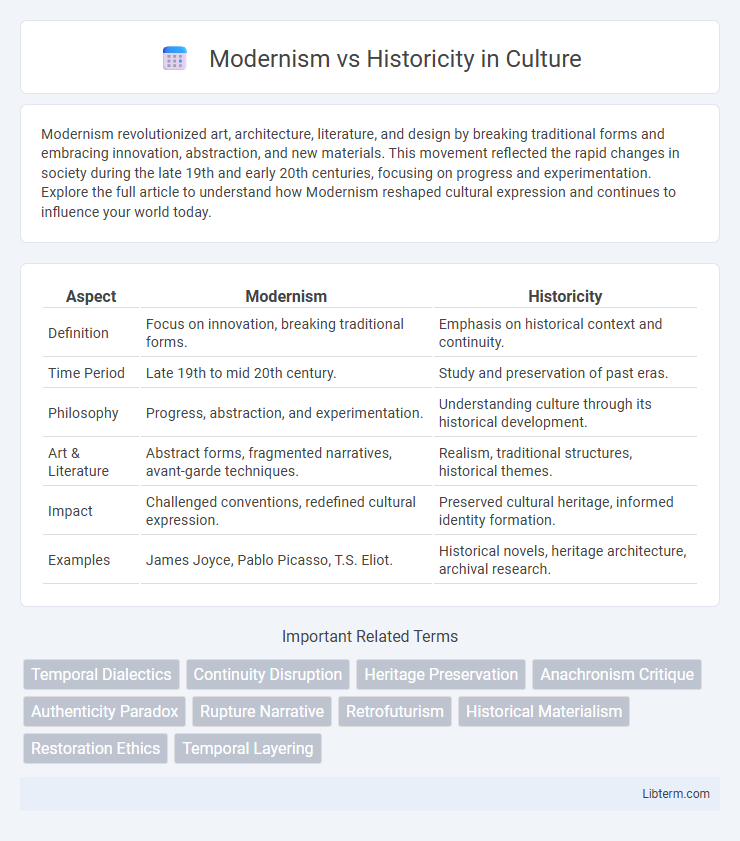Modernism revolutionized art, architecture, literature, and design by breaking traditional forms and embracing innovation, abstraction, and new materials. This movement reflected the rapid changes in society during the late 19th and early 20th centuries, focusing on progress and experimentation. Explore the full article to understand how Modernism reshaped cultural expression and continues to influence your world today.
Table of Comparison
| Aspect | Modernism | Historicity |
|---|---|---|
| Definition | Focus on innovation, breaking traditional forms. | Emphasis on historical context and continuity. |
| Time Period | Late 19th to mid 20th century. | Study and preservation of past eras. |
| Philosophy | Progress, abstraction, and experimentation. | Understanding culture through its historical development. |
| Art & Literature | Abstract forms, fragmented narratives, avant-garde techniques. | Realism, traditional structures, historical themes. |
| Impact | Challenged conventions, redefined cultural expression. | Preserved cultural heritage, informed identity formation. |
| Examples | James Joyce, Pablo Picasso, T.S. Eliot. | Historical novels, heritage architecture, archival research. |
Defining Modernism and Historicity
Modernism is characterized by a break with traditional forms and an emphasis on innovation, abstraction, and the search for universal truths through reason and progress. Historicity refers to the condition of being rooted in or shaped by historical context, emphasizing the importance of temporal and cultural specificity in understanding human experience. The tension between Modernism and Historicity highlights the conflict between universal ideals and contextual particularity in art, literature, and philosophy.
Historical Roots of Modernist Thought
Modernist thought emerged from the 19th-century intellectual movement challenging traditional historicity and linear narratives of history, emphasizing progress, innovation, and the rejection of past conventions. Influential figures such as Friedrich Nietzsche and Sigmund Freud questioned established truths and introduced concepts of subjectivity and unconscious forces shaping human experience. The modernist focus on breaking away from historic determinism reflected broader cultural shifts during the Industrial Revolution and rapid urbanization in Europe.
The Essence of Historicity in Cultural Context
The essence of historicity in cultural context emphasizes the continuous interplay between past events and contemporary societal values, shaping identity and collective memory. Unlike Modernism, which often advocates for breaking with tradition to embrace innovation and progress, historicity grounds cultural experiences in historical continuity and interpretation. This dynamic ensures that cultural expressions are deeply rooted in historical awareness, fostering a nuanced understanding of how past influences inform present realities.
Key Differences Between Modernism and Historicity
Modernism emphasizes innovation, abstraction, and a break from traditional forms, focusing on forward-looking perspectives and individual expression. Historicity centers on the preservation, interpretation, and understanding of historical context and cultural continuity, highlighting the importance of temporal and social factors in shaping meaning. Key differences lie in modernism's pursuit of new artistic methods versus historicity's commitment to historical authenticity and context-driven narratives.
Modernism’s Impact on Art and Architecture
Modernism revolutionized art and architecture by rejecting traditional styles and embracing innovation, abstraction, and functionalism. It introduced minimalism, new materials like steel and glass, and emphasized simplicity and form following function, influencing iconic works such as Le Corbusier's Villa Savoye and the Bauhaus movement. This shift marked a departure from historicist ornamentation towards a forward-thinking aesthetic that prioritized human experience and industrial progress.
Historicity’s Influence on Societal Narratives
Historicity profoundly shapes societal narratives by anchoring stories in the context of temporal authenticity and lived experience, ensuring collective memory remains dynamic and reflective of cultural evolution. It enables societies to critically engage with past events, fostering a shared identity anchored in historical continuity and transformation. This influence counters Modernism's tendency toward abstraction by emphasizing the significance of historical context in shaping meaning and social values.
Case Studies: Modernist vs. Historicist Approaches
Modernist approaches in architecture emphasize innovation, abstraction, and the use of new materials and technologies, prioritizing function and simplicity as seen in Le Corbusier's Villa Savoye. Historicist approaches focus on preserving historical context, incorporating traditional styles and craftsmanship, exemplified by the restoration of the Palace of Westminster. Case studies highlight the tension between forward-looking design philosophies and the reverence for cultural heritage in shaping the built environment.
Contemporary Debates on Modernism vs. Historicity
Contemporary debates on Modernism vs. Historicity center on the tension between innovation and tradition in art, architecture, and cultural theory, emphasizing how modernist ideals challenge or reinterpret historical contexts. Critics argue that Modernism's emphasis on progress and breaking with the past often neglects the complexities of historical continuity and cultural memory. Scholars analyze this dialectic to understand how contemporary practices negotiate identity, heritage, and the evolving definitions of modernity within historical frameworks.
The Future of Modernism and Historicity
The future of Modernism involves integrating advanced technology and innovative materials to redefine architectural aesthetics while maintaining functional simplicity. Historicity emphasizes preserving cultural context and heritage, fostering a dialogue between past and present in urban development. Emerging trends suggest a hybrid approach where progressive design respects and revitalizes historical narratives, ensuring sustainable and meaningful environments.
Synthesizing Modernism and Historicity in Practice
Synthesizing modernism and historicity in practice involves integrating the forward-looking principles of innovation and abstraction with a deep respect for historical context and cultural continuity. This approach balances cutting-edge design and technology with preservation of heritage, ensuring that new structures or ideas resonate meaningfully within their specific historical settings. By merging modernist aesthetics and functionality with authentic historical narratives, architects and scholars create spaces and concepts that honor the past while addressing contemporary needs.
Modernism Infographic

 libterm.com
libterm.com